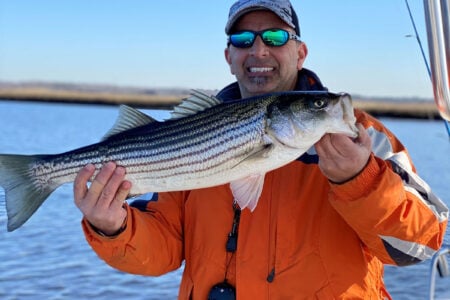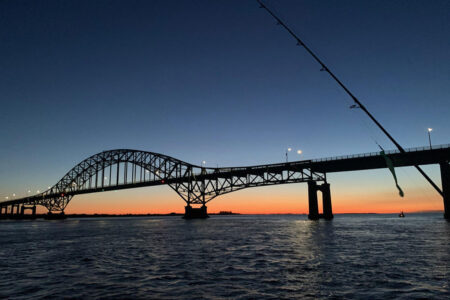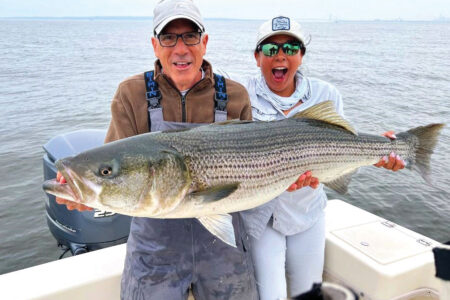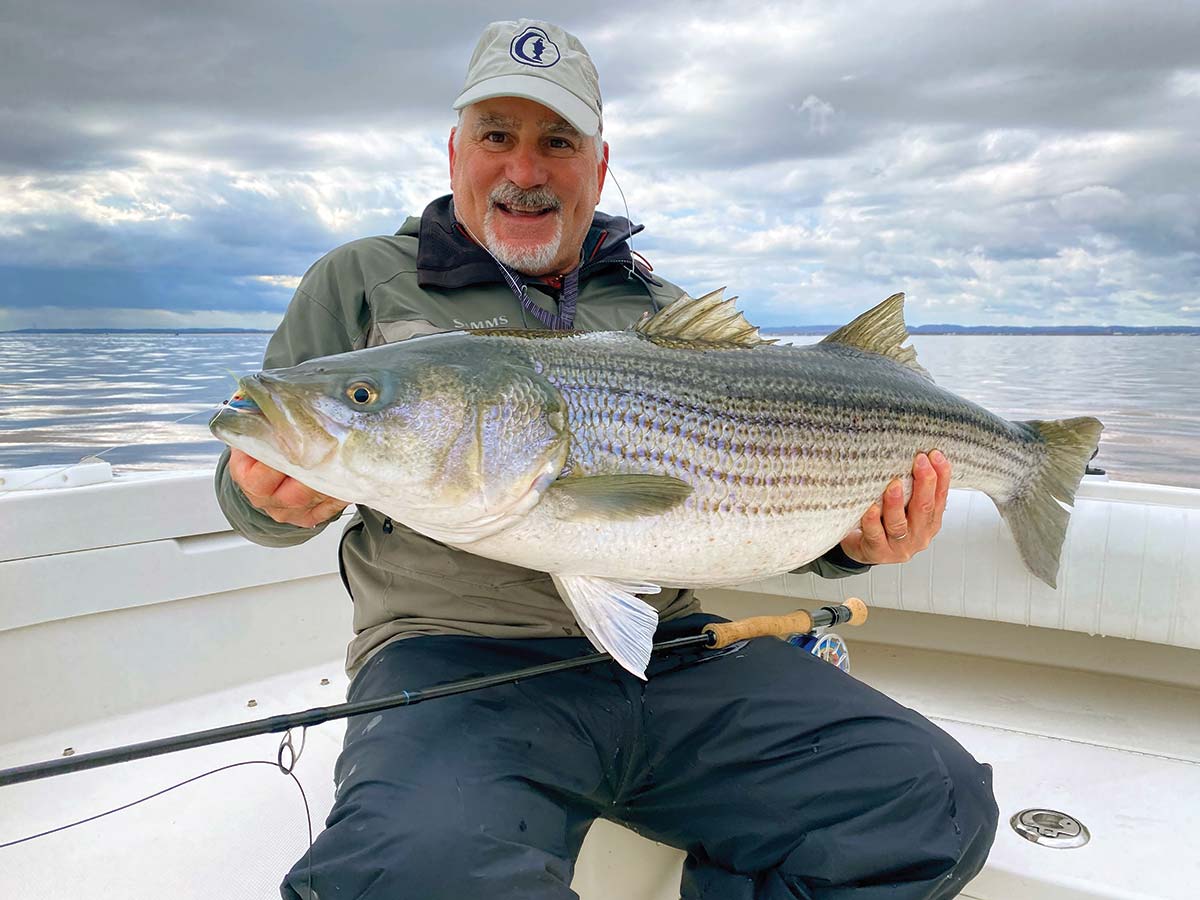
Teamwork will lead to your next fly rod personal best
A few years back my friend Pat and I decided to brave the elements on a cold and rainy spring morning with a 15- to 20-knot breeze out of the northeast. I knew that we would be able to fish open water in the lee on the other side of the bay, so we gathered up our gear and made the 20 minute run across Raritan Bay. When we arrived for our first drift, we found out rather quickly that it was going to be a great day. There was not another boat in sight and we were tight to fish ranging from 15 to 35 pounds right off the bat.
These fish were responding to metal-lip swimmers but mostly wanted topwater lures, especially the “Doc.” We tried casting large hollow flies on sinking and intermediate lines, but we couldn’t buy a bite on feathers. I learned about the Doc many years ago while fishing with Capt. Corey Pietraszek of Plug n’ Play Charters in Buzzards Bay, MA. Corey was one of the pioneers of converting this lure, developed in the Midwest for musky, into a striped bass feeding machine. On top of that, he was able to keep it a secret for many years. For those who are not familiar with the Doc, it’s a 9-inch-long plastic spook with a pair of low frequency rattles. Those who have used this lure know that it is the ultimate weapon for feeding tricky, large striped bass. After landing as many fish as we wanted on the Doc, we decided to fire one out without hooks to tease a few of these bass up to the surface and to try to entice them to eat a fly. For the rest of the day we alternated with one person throwing the hookless plug, known by some as a teaser, and the other casting the fly rod.
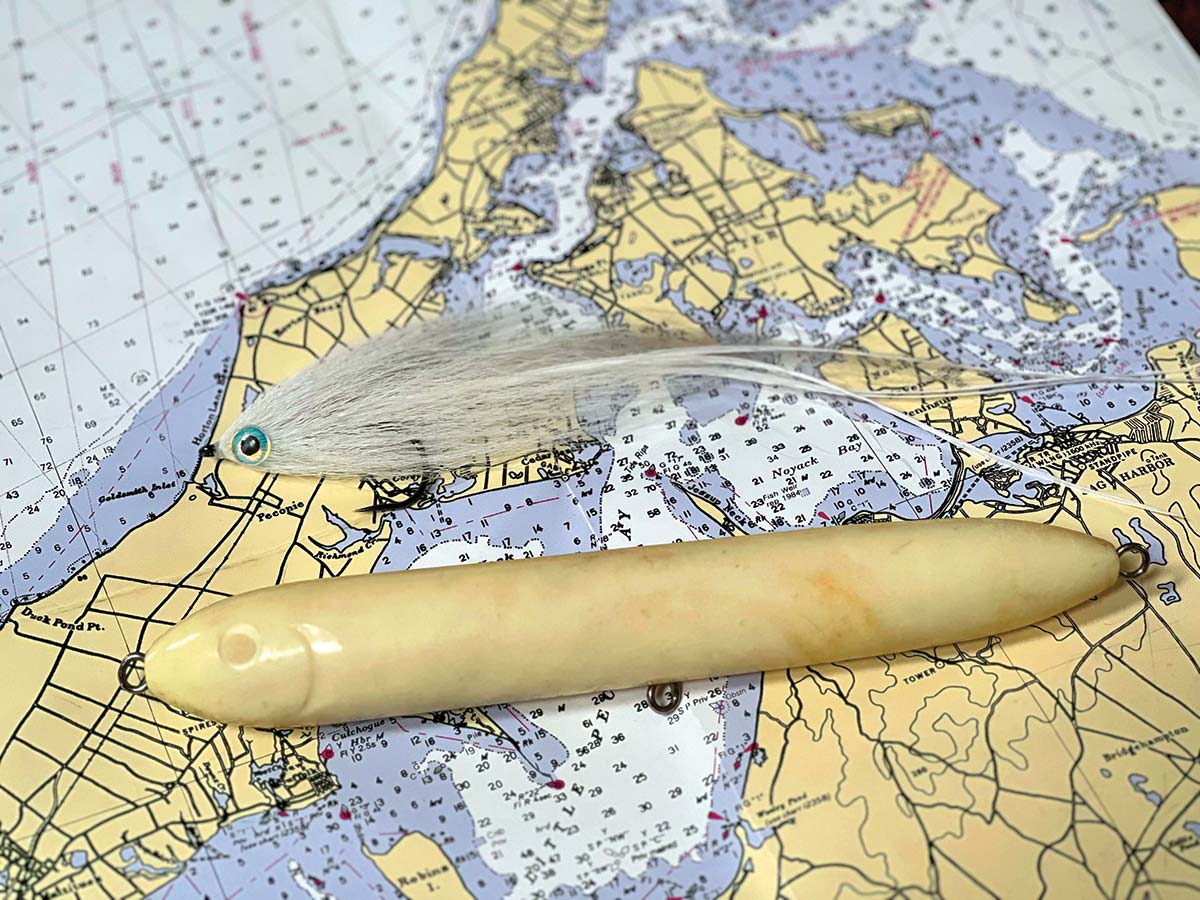
Bait & Switch
The bait and switch technique can be used for just about any predatory species that will eat a topwater lure. Aside from striped bass, I have seen it used for bluefin tuna, bluefish and false albacore, just to name a few. Striped bass, specifically, rely on their lateral lines to sense their prey, which makes a noisy plug that throws a ton of water an ideal search bait. It is very hard to design a fly that can cast reasonably well but can also push as much water and make as much noise as the Doc. You can add bulk and rattles to flies, but it is very difficult to create a fly that can capture a striper’s attention from a long distance like a plug can and also cover a lot of water.
I typically position my boat up current or upwind of the area I plan on fishing, this can either be a piece of structure or a flat (3-12 feet deep) that I suspect is holding fish. Be careful not to cross too close to the structure or directly over the area that you want to fish at a speed any higher than an idle, as it will spook the fish. When prospecting a flat, I keep a close eye on my sonar. The fish will appear as subtle bumps on the bottom in shallow water. If you have a side-scan sonar, this is a great time to use it to locate fish. I will generally go up a considerable distance from where I plan to fish, turn my motor off and drift back over the area that I am targeting. I like to position the boat so that it will drift down wind or down current with the beam of the boat leading.
Ideally you will have anglers on the boat that can sufficiently cast both a spin and fly rod. Depending on the setup of your boat, you can determine the best way to accommodate the angler with the fly rod and the angler casting the teaser (the plug in this case). Assuming that my fly caster is right handed, I like to position the boat so that the port side is leading the boat down current. This allows the fly caster to fish in the furthest forward position and the teaser to stand to their left-hand side. This also usually gives both anglers a downwind cast. If the fly caster is left-handed, I will position the boat facing the opposite direction.
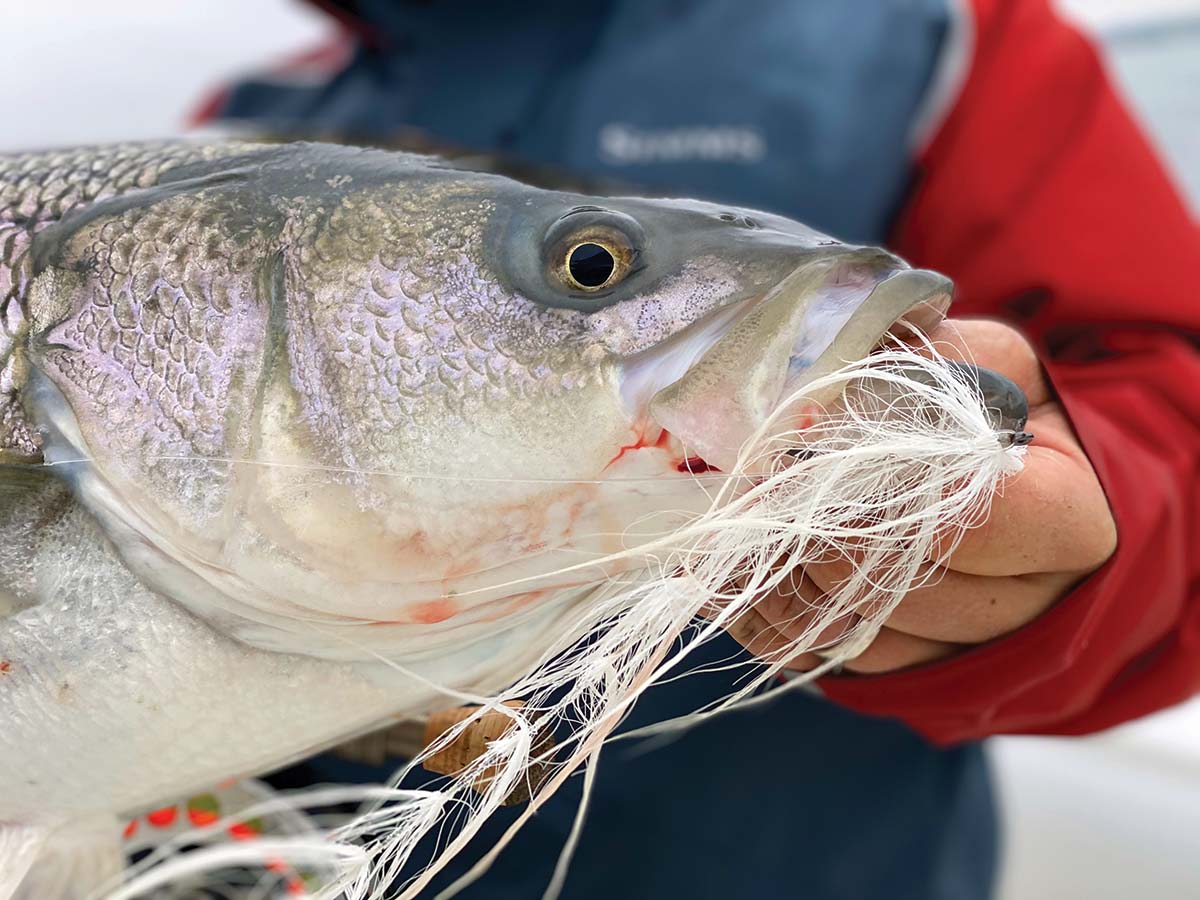
The Method
The fly caster should strip out as much line as they are comfortable casting. Make sure to coil the line neatly on the deck or in a stripping basket so that it is not stepped on while casting or when hooked up to a fish. The angler working the teaser should fan cast the area if they are not getting attention from the fish while casting downwind. Vary the retrieve to help get the fish’s attention. Once the teaser has caught the attention of the fish, it is their job to keep the fish interested in the lure until it’s in range of the fly caster. I like to speed up my retrieve to keep the fish interested. Once in range, the fly caster should quickly deliver the fly. Keep in mind that the plug and the fish are both moving toward the boat and the boat is drifting toward the fish, so do not aim for the plug or the fish, keep it about 5 to10 feet short and allow the teaser to bring the fish right to your fly. It is important for the teaser to pull the plug away quickly so that the fish only sees the fly after the fly has landed and is moving in the water—the best teasers will jerk the plug into the air and may even catch it in their hand—you basically want the plug to disappear from the situation. The more seamless this transition is, the higher the chance of hooking up.
You will most likely be able to see the fish, so try to maintain a strip speed and cadence similar to how the plug was swimming. If the fish speeds up, speed up your retrieve to try to imitate a fleeing baitfish. By reading the fish’s body language and learning how to force them into eating you will improve your angling skills immensely. Fish the fly right to the boat, if you are not getting the attention of a fish, try slowing down. This will give the fish more time to see the fly and will also allow it to sink a little bit more in case they are following deep.
There will be days when the fish are not chasing the teaser aggressively. Keep an eye on the water after the retrieve, because often times you will see swirls from fish that were just following the lure deep and spooked at the boat. On days like this, I suggest using the same technique as you would when the fish are showing. Switch out the teaser with the fly at a distance that the caster can comfortably cast to. The further the fly caster can toss it, the more of an advantage they will have because it will give them more “runway” to feed the fish prior to the fish seeing the boat and spooking, so practice your casting for both distance and accuracy.
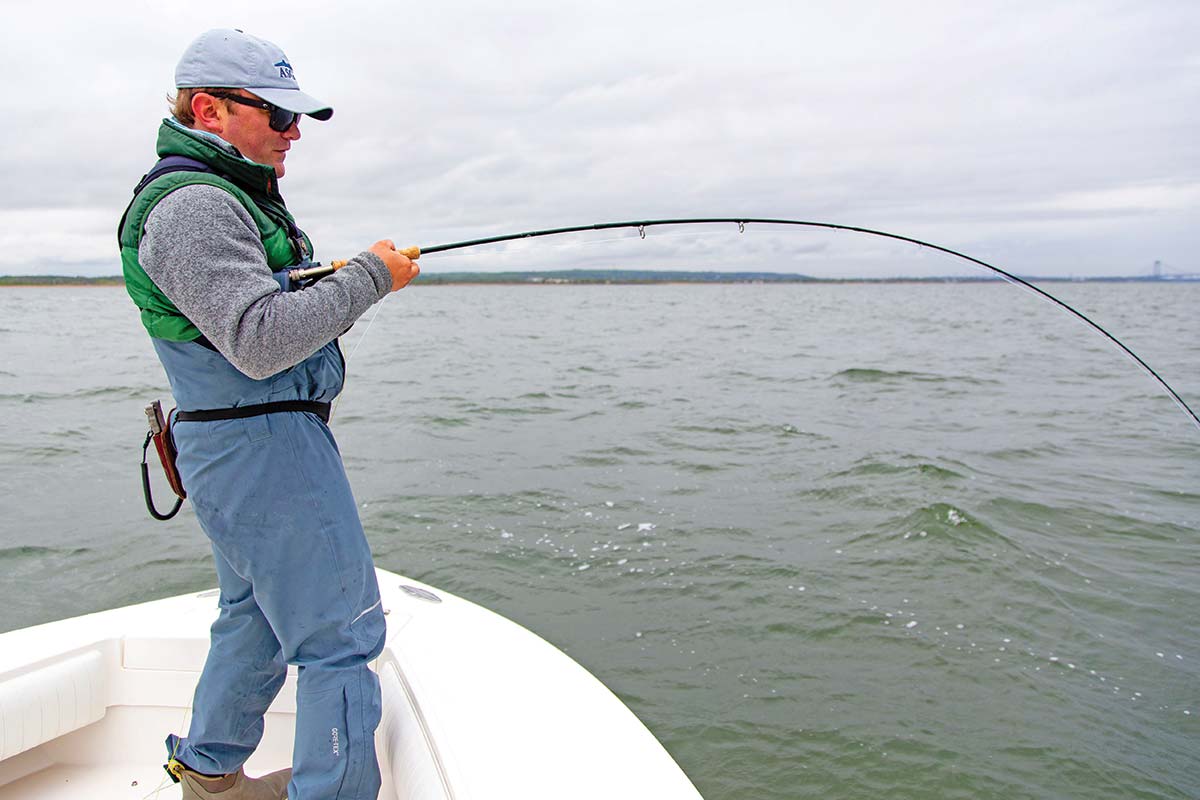
Tools Of The Trade
As far as the spinning or teasing gear goes, you just want to have rod that can throw and work a heavy lure. Any sort of spook or popper will work. If the bait is smaller, try using a smaller lure and match your fly to the forage. In the spring when the fish are on adult bunker, stick with the larger lures and flies.
For fly gear, I suggest a rod ranging from 9 to 11 weight. If you are a novice caster, a heavier line size will make casting larger flies easier. In addition, an intermediate line can be easier to shoot than a floater, especially in the wind. Personally, I prefer a floating line because it allows for a quick pick up and the ability to reshoot if the fish moves or if you are off on your initial shot. A line with a shorter head and a more aggressive front taper will make turning over a larger fly quite a bit easier, too.
Leaders should be short and stout. I usually build my leaders with all fluorocarbon starting with a 50-pound butt section that is about 3 feet long and then taper down to a 40-pound section that is 2 feet long, followed by a 2 foot section of 20 to 30 pound, depending on your preference. I use 20, but if you are novice, I suggest using 25 or 30. Most fish are lost on the hookset. The flies that we use in these situations tend to have beefy hooks that are 5/0 or higher. This requires a sharp hookset to penetrate the fish’s jaw. Make sure to let the fish run after the hookset, or you will lose your fly and the perhaps the fish of a lifetime!
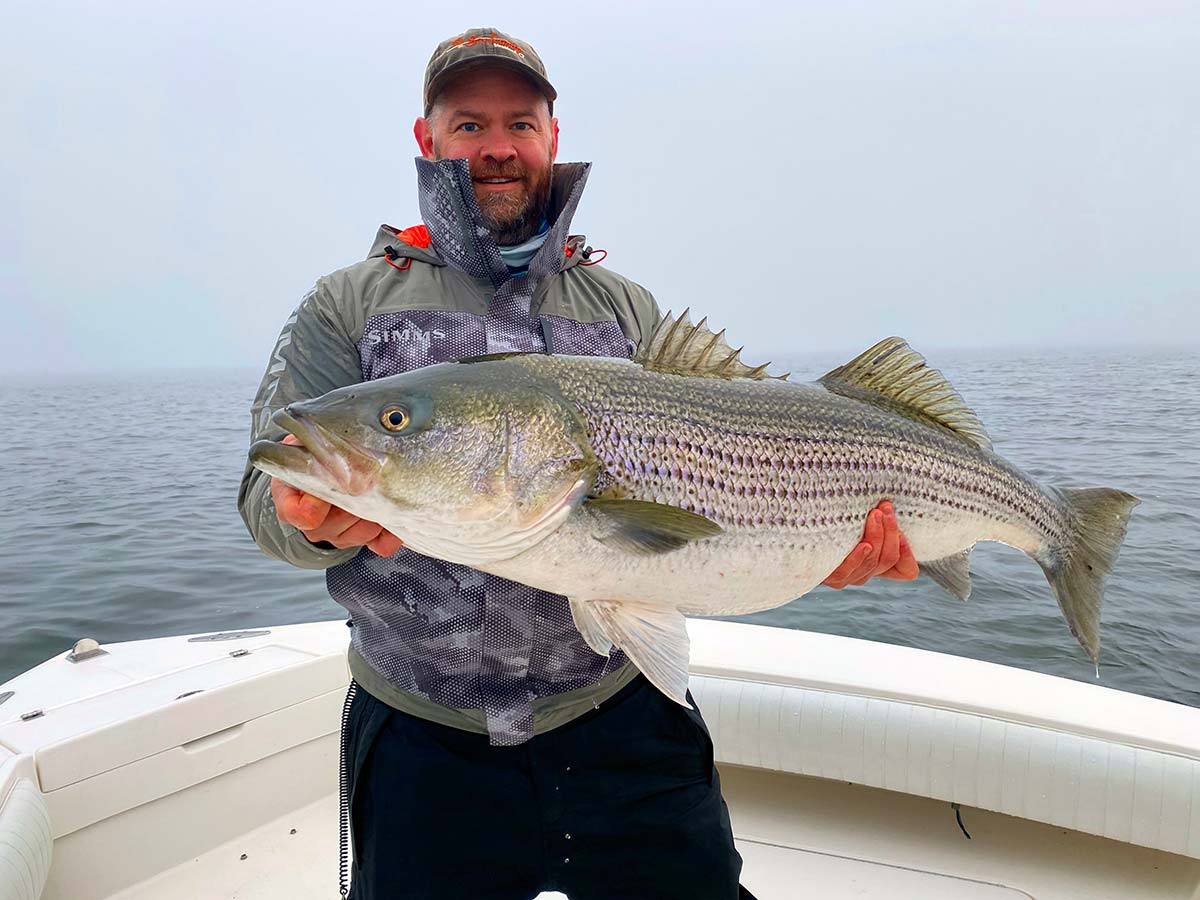
As far as flies go, make it look like your teaser! The whole point is to trick the fish into believing the fly is the plug they’ve been following. I like to tie Popovic’s Hollow Fleye in all white. This design is excellent because you can tie it relatively sparsely but still maintain a large profile, which makes it pretty easy to cast for its size. I usually tie mine 9 to 12 inches long. Another great option is Popovic’s Beast Fleye. One final pattern that has become popular on my boat in recent years has been Jonny King’s Kinky Muddler. These flies hold up extremely well and push a ton of water.
In my area, the best time to get a trophy on the fly rod is in the spring. The copious amount of big bunker makes the bait and switch method the best method for catching a big bass on the fly, so make sure your casting is dialed in and find a dependable fishing partner or guide who can help you bait and switch the fly rod bass that you have been dreaming about all winter.
Tom Kosinski is a USCG licensed Captain. His passion for saltwater fishing began at a young age after catching his first striped bass with his father while fishing the Navesink River. Tom gravitated to surfcasting and traveled all over New England in search of a trophy from the suds. More recently Tom has found a passion for chasing various species on fly and light tackle from his boat. From pursuing giant stripers on Raritan Bay in the early spring, to sight fishing the flats of New England in the summer, Tom is always on the water.
Follow Tom on Instagram @tkos5250 or visit his website at www.sandyhookoutfitters.com

